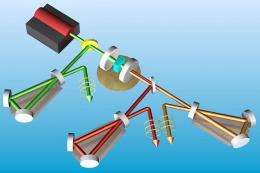October 7, 2009 feature
Physicists Demonstrate Three-Color Entanglement

(PhysOrg.com) -- For the first time, physicists have demonstrated the quantum entanglement of three light beams, all of different wavelengths. Entanglement of two light beams of different wavelengths has already been demonstrated, but the researchers explain that going beyond two beams is important since three beams can serve as connections at the nodes of a quantum network.
The team of scientists, from the University of Sao Paulo in Brazil, and the Max Planck Institute for the Science of Light and the University of Erlangen-Nuremberg, both in Erlangen, Germany, has published their results in a recent issue of Science Express.
“We generate directly a higher order of entanglement among bright beams of light (in general, continuous variable systems), enabling us to entangle light of different colors,” Paulo Nussenzveig of the University of Sao Paulo told PhysOrg.com.
The physicists are working toward the goal of building a quantum information network, in which entangled light beams convey information from one place to another. Although quantum entanglement is expected to greatly speed up information processing, currently several technological challenges remain. For instance, quantum resources are fragile and undergo decoherence when interacting with the surrounding environment, which is harmful for applications.
As the physicists explain, a variety of physical systems will likely be combined to perform quantum information tasks. However, since these diverse systems lack a means of connection, they need a way to join together at the nodes of the quantum network. With this problem in mind, the physicists have investigated using different frequencies of light to connect different components of a quantum network.
“The most investigated systems are trapped ions, superconducting flux qubits, quantum dots, polaritons, and others,” Nussenzveig said. “Most have specific advantages and other disadvantages. In our view, one could envisage applications to start in hybrid systems, taking advantage of the best characteristics of each of these pieces of quantum hardware.“
As Nussenzveig explained, light is the best candidate to convey quantum information. However, light-matter information exchange cannot take place for light of any frequency. In general, these material systems interact with light at particular resonance frequencies.
“Let's say we would like to convey the information stored in a collection of rubidium atoms to some far node in a quantum network,” he said. “The atoms interact with light at 780 nm, a wavelength that does not propagate very efficiently through optical fibers. So, we would like to change the wavelength of light that will convey the information to 1,550 nm. On the other end, we would like to store the information in a quantum dot, resonant at 800 nm. Three-color entangled light could do that job (not with our present set-up, but it is a proof-of-principle).”
To generate entanglement with three wavelengths (colors) of light, the physicists used an optical parametric oscillator (OPO). The OPO, which consists of a cooled crystal inside a cavity, oscillates at different frequencies, and can convert one input wave into two longer-wavelength output waves in a process called parametric down-conversion.
When the beam reached the OPO, it was converted into two beams, while the original pump beam was recovered after interacting with the crystal inside the cavity. The resulting pair of down-converted modes (twin beams) possessed strong correlations among its two parts, as well as with the mode that gave birth to them. The scientists verified tripartite entanglement among these three light modes, and showed that the wavelengths of the beams could be tuned by constraining the phase variations of the three fields. Here, the wavelengths of the three light beams were 532 nm, 1,062 nm, and 1,066 nm.
When assessing the robustness of the tripartite entanglement, the researchers found that sometimes the light modes quickly become disentangled, an effect reminiscent of so-called entanglement sudden death. This disentanglement could be harmful for quantum communications applications, such as information networks. However, the scientists also found that the effect doesn’t occur for all oscillation frequencies. This interesting result reveals that robustness of entanglement can change, indicating that entangled states are not all of the same nature. The scientists predict that this disentanglement should be observable in other continuous variable systems, and serves as a reminder that much is still unknown about the nature and dynamics of quantum entanglement.
“Most people think that we already know (almost) all there is to know about entanglement of Gaussian states,” Nussenzveig said. “But we've observed two Gaussian states, both presenting tripartite entanglement, which have a different robustness with respect to channel losses. They clearly have different properties: why is that so? How can we tell, beforehand, if a certain Gaussian entangled state will be robust or not? We believe there are still fundamental issues that remain to be understood: the sudden death we observed is an indicator of this necessity.”
More information: A.S. Coelho, et al. “Three-Color Entanglement.” Science Express. 17 September 2009. 10.1126/science.1178683.
Copyright 2009 PhysOrg.com.
All rights reserved. This material may not be published, broadcast, rewritten or redistributed in whole or part without the express written permission of PhysOrg.com.

















